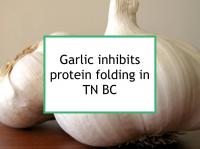Garlic has been linked to reduced risks of both hormone receptor positive (ER+/PR+) and hormone receptor negative (ER-/PR-) breast cancer. The effects of garlic appear to be primarily caused by organosulfur compounds, including diallyl sulfide, diallyl disulfide, diallyl trisulfide, diallyltetrasulfide, dipropyltetrasulfide and ajoene.
Garlic is also a good source of apigenin and enterolactone, both of which have chemopreventive properties. Organosulfur compounds are produced upon chopping or chewing garlic. Although some of the anticancer activities of garlic are retained after cooking or processing it, raw garlic appears to have the most benefits.
Garlic compounds have been shown to reduce proliferation and angiogenesis (the growth of new blood vessels), and induce apoptosis (programmed cell death) in breast cancer cells. Garlic compounds can also inhibit DNA synthesis in breast cancer cells and retard their growth. Diallyl trisulfide has been shown to suppress breast cancer cell invasion and metastasis, thereby delaying the onset or progression of breast cancer. Diallyl disulfide has been shown to decrease carcinogen-induced cancers in experimental animals.
Now a new study has reported that the organosulfur compound ajoene interferes with protein folding in triple negative breast cancer cells, which in turn causes their death.
Latest research shows how garlic interferes with TN cell function
The study referenced at the beginning of this news story was designed to investigate the mechanism of action by which ajoene exerts cytotoxic effects in triple negative breast cancer cells. Ajoene is an organosulfur compound found in crushed garlic that has been shown to arrest cancer cell growth and induce programmed cell death.
To conduct the study, the authors synthesized two fluorescently labelled ajoene compounds with dansyl- (DP) and fluorescein- (FOX) tags. The authors then confirmed that these compounds retained their antiproliferative and pro-apoptosis activities in MDA-MB-231 triple negative (ER-/PR-/HER2-) breast cancer and WHCO1 esophageal cancer cells.
Both tagged ajoenes localized to the endoplasmic reticulum of MDA-MB-231 cells. The endoplasmic reticulum consists of a network of tubular membranes within the cytoplasm of a cell. One of the functions of the endoplasmic reticulum is the synthesis and transport of proteins. Using a variety of techniques, the authors showed that ajoene interfered with protein folding and led to an accumulation of misfolded protein aggregates. This in turn activated the unfolded protein response, a cellular repair process which begins with attempts to restore normal function and, if this fails, results in apoptosis.
The authors comment that this is the first time that ajoene has been shown to target protein folding in the endoplasmic reticulum of cancer cells.
